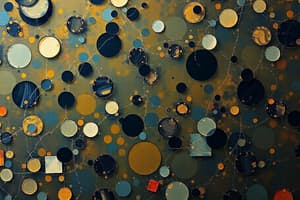Podcast
Questions and Answers
Which type of inhibitor competes with the substrate for the active site of the enzyme?
Which type of inhibitor competes with the substrate for the active site of the enzyme?
- Allosteric inhibitors
- Noncompetitive inhibitors
- Competitive inhibitors (correct)
- Feedback inhibitors
Which type of inhibitor binds to a specific site away from the active site, causing conformational changes in the enzyme?
Which type of inhibitor binds to a specific site away from the active site, causing conformational changes in the enzyme?
- Allosteric inhibitors (correct)
- Feedback inhibitors
- Competitive inhibitors
- Noncompetitive inhibitors
What is the mechanism by which noncompetitive inhibitors inhibit enzyme activity?
What is the mechanism by which noncompetitive inhibitors inhibit enzyme activity?
- By binding to the active site of the enzyme
- By increasing substrate concentration
- By altering the shape of the enzyme (correct)
- By competing with the substrate for the active site
Which type of inhibitor binds to the enzyme or represses the gene coding for the enzyme, inhibiting the biosynthetic pathway?
Which type of inhibitor binds to the enzyme or represses the gene coding for the enzyme, inhibiting the biosynthetic pathway?
What is indicative of increased rate of release from the tissues in plasma enzymes of clinical significance?
What is indicative of increased rate of release from the tissues in plasma enzymes of clinical significance?
What is the main effect of enzyme inhibition?
What is the main effect of enzyme inhibition?
Which type of inhibitor acts on only one enzyme or a small group of enzymes?
Which type of inhibitor acts on only one enzyme or a small group of enzymes?
How do irreversible inhibitors affect enzymes?
How do irreversible inhibitors affect enzymes?
Which classification of enzyme inhibitors affects a wide variety of enzymes?
Which classification of enzyme inhibitors affects a wide variety of enzymes?
What is the result of substrate binding to an enzyme via the active site?
What is the result of substrate binding to an enzyme via the active site?
Flashcards are hidden until you start studying
Study Notes
Enzyme Inhibitors
- Competitive inhibitors compete with the substrate for the enzyme's active site, blocking the substrate from binding.
- Noncompetitive inhibitors bind to a location away from the active site, leading to conformational changes that reduce enzyme activity.
- Noncompetitive inhibition mechanism involves reducing the maximum rate of reaction (Vmax) without affecting the affinity of the enzyme for the substrate (Km remains unchanged).
- Irreversible inhibitors permanently bind to the enzyme, often leading to a loss of enzyme activity because they modify the active site.
- Allosteric inhibitors can bind to sites other than the active site, regulating enzyme activity through conformational changes.
Enzyme Activity and Regulation
- Feedback inhibitors can repress the gene coding for an enzyme or directly inhibit the enzyme itself, thereby blocking a biosynthetic pathway.
- Clinical significance of plasma enzymes is indicated by a heightened rate of release from tissues, commonly assessed in diagnostic tests.
- The primary effect of enzyme inhibition is to decrease the rate of product formation within a biochemical pathway.
Specificity and Range of Inhibition
- Specific inhibitors target only one enzyme or a small group, allowing for precise control in metabolic processes.
- Broad-spectrum inhibitors can affect a wide range of enzymes, potentially impacting multiple pathways simultaneously.
- The binding of a substrate to an active site typically leads to an enzyme-substrate complex formation, which is essential for catalyzing the conversion of substrates to products.
Studying That Suits You
Use AI to generate personalized quizzes and flashcards to suit your learning preferences.




